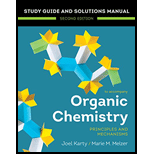
(a)
Interpretation:
A synthetic step for the given transformation, including reagents and special reaction conditions in the forward direction, is to be written.
Concept introduction:
Synthesis may be designed by thinking in the reverse direction, from the product to the starting compound, in a method called retrosynthesis. A synthesis is a specific sequence of
The Hofmann elimination reaction leads to an anti-Zaitsev elimination product or Hofmann product. An amine with a poor leaving group is converted into a tetraalkyl ammonium ion, which has a moderately good leaving group, using excess of an
(b)
Interpretation:
A synthetic step for the given transformation, including reagents and special reaction conditions in the forward direction, is to be written.
Concept introduction:
Synthesis may be designed by thinking in the reverse direction, from the product to the starting compound, in a method called retrosynthesis. A synthesis is a specific sequence of chemical reactions that converts the starting materials into the desired compound, called the target (or synthetic target). The product given in the retrosynthetic step is the precursor for the synthetic step, followed by an arrow
Reaction with LDA leads to alkylation at the less highly alkyl substituted carbon atom.
(c)
Interpretation:
A synthetic step for the given transformation, including reagents and special reaction conditions in the forward direction, is to be written.
Concept introduction:
Synthesis may be designed by thinking in the reverse direction, from the product to the starting compound, in a method called retrosynthesis. A synthesis is a specific sequence of chemical reactions that converts the starting materials into the desired compound, called the target (or synthetic target). The product given in the retrosynthetic step is the precursor for the synthetic step, followed by an arrow
Esterification is the reaction of acid with diazomethane to form the desired ester as a product.
(d)
Interpretation:
A synthetic step for the given transformation, including reagents and special reaction conditions in the forward direction, is to be written.
Concept introduction:
Synthesis may be designed by thinking in the reverse direction, from the product to the starting compound, in a method called retrosynthesis. A synthesis is a specific sequence of chemical reactions that converts the starting materials into the desired compound, called the target (or synthetic target). The product given in the retrosynthetic step is the precursor for the synthetic step, followed by an arrow
Most hydrogen halide reactions with
Trending nowThis is a popular solution!

Chapter 13 Solutions
EBK ORGANIC CHEMISTRY: PRINCIPLES AND M
- Fill-in-the molecules for the oxidation or reduction of the starting alcohol.arrow_forwardName the following carbohydrates give both the systematic and common names. Don't forget to identify the Isomer.arrow_forwardWhat is the product of the reaction of XeF4 with H2O? Group of answer choices H2XeF2 H2XeF4 XeO3 H2XeOarrow_forward
 Organic Chemistry: A Guided InquiryChemistryISBN:9780618974122Author:Andrei StraumanisPublisher:Cengage Learning
Organic Chemistry: A Guided InquiryChemistryISBN:9780618974122Author:Andrei StraumanisPublisher:Cengage Learning
